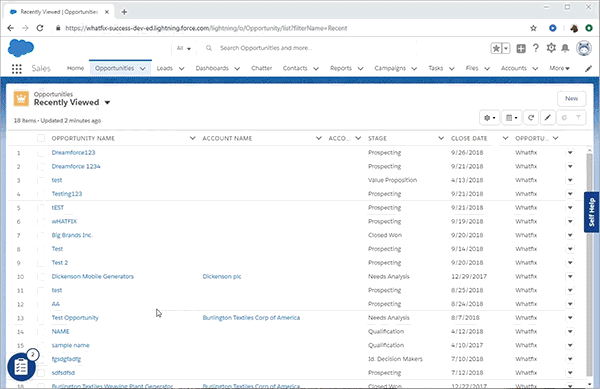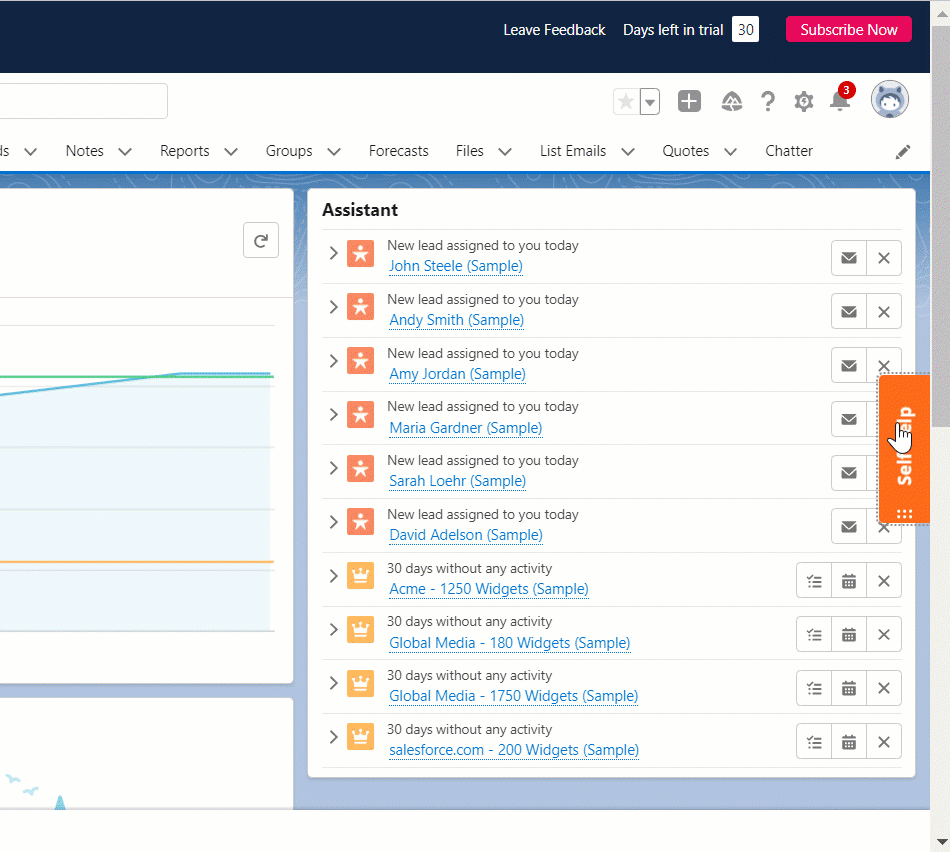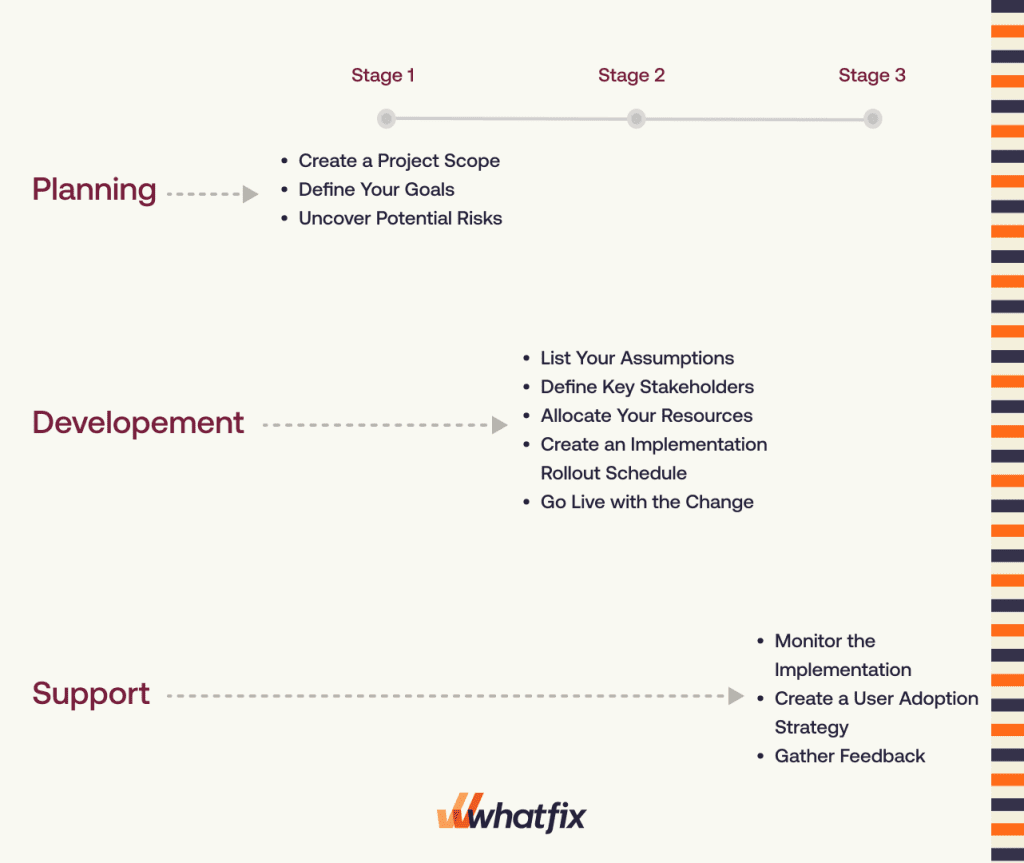
Levi Olmstead


A new software implementation is a complex endeavor that becomes even more intricate when it involves cloud transformation and legacy application modernization.
Without a clear and comprehensive SaaS implementation plan, the journey from planning to launch is challenging and risky, potentially leading to poor end-user adoption, low productivity, and failed technology ROI.
Creating an effective SaaS implementation plan is crucial in translating your change management strategy from theory into practice. Developing a plan that is actionable, feasible, and detailed provides a roadmap to navigate the complexities of SaaS projects, ensuring that your digital transformation initiatives are successful and drive business outcomes from technology investments.
In this article, we’ll explore how to create a SaaS implementation plan for migrating to new cloud technologies, the benefits of a well-planned implementation plan, and the challenges IT teams may face on the path to end-user adoption.
A SaaS implementation plan is a comprehensive IT roadmap that guides businesses through the transition process of integrating and adopting a new SaaS platform into their day-to-day operations.
Unlike traditional software implementation, a SaaS implementation plan emphasizes cloud-based service models, focusing on anywhere accessibility, subscription-based usage, and continuous updates. It involves strategic planning, resource allocation, and stakeholder engagement to ensure a smooth transition to the cloud, minimize disruptions, and optimize the use of the SaaS application for long-term business growth and efficiency.
The types of SaaS implementation plans can vary based on several factors, like the scale of the implementation, the complexity of the business processes, and the specific needs of the organization. Here are some common types:
Whether you’re introducing a new software solution, launching a cloud-based product, or initiating a company-wide digital transformation, crafting a specific SaaS implementation plan is essential for turning innovative concepts into actionable and achievable goals. Without a clear direction to guide you, your project runs a higher risk of failure.
Clarifying your goals and developing a plan for achieving them adds structure to processes with many moving parts. Gaining that clarity can provide the following benefits:
A SaaS-specific implementation plan outlines integrating cloud-based services with existing infrastructure. This integration is crucial, as it ensures that new and legacy systems work in tandem without data silos or operational hiccups. It covers protocols for data syncing, API integrations, and user interface compatibility, all while maintaining system integrity. Such thorough planning is key to avoiding disruptions in daily operations and ensuring a seamless transition to the new SaaS environment.
Data migration is a cornerstone in SaaS implementations, and a detailed plan is essential for its success. This involves not only moving data to the cloud securely, but also transforming and structuring it to fit the new environment. The plan covers aspects like data cleaning, mapping, testing, and validation, ensuring minimal data loss and downtime. Focusing on data security and privacy is also integral, particularly in maintaining compliance with regulations like GDPR or HIPAA.
SaaS solutions are inherently scalable, and a well-crafted plan addresses this head-on. It anticipates future business growth, outlining how the SaaS solution can adapt to increasing demands or changing business processes. The plan includes scalability benchmarks and triggers for scaling up or down, ensuring the solution remains cost-effective and efficient. This foresight is crucial for businesses looking to evolve and expand without the need for extensive overhauls or system replacements.
With the shift to cloud-based services, managing security and compliance becomes more complex. A SaaS-specific implementation plan prioritizes these aspects, detailing measures to protect data both in transit and at rest, and ensuring that all aspects of the solution comply with industry standards and legal requirements. It includes regular security audits, access controls, and data encryption strategies, which protect valuable data and build trust with customers and stakeholders.
End-user adoption is a critical measure of success for SaaS implementations. A comprehensive plan includes detailed strategies for contextual end-user training and support, ensuring users are comfortable with the new system through in-app guided experiences and moment-of-need help.
This involves creating user-friendly guides, conducting training sessions, and providing real-time performance support that addresses any workflow questions or user concerns.
By investing in a digital adoption strategy, organizations enable their employees with the knowledge and support they need to utilize new SaaS investments to their full potential, helping to drive technology ROI and achieve business outcomes,
Digital adoption platforms (DAPs) like Whatfix empower IT teams with a no-code editor to create in-app guidance and performance support content such as Tours, Task Lists, Smart Tips, Flows, Field Validations, and more.

Enable your end-users with contextual in-app Flows based on their role, end-user type, department, etc. Use Task Lists to quickly onboard new end-users and get them proficient quickly. Smart Tips provide added context at key friction areas to help employees follow your processes.

Self Help enables end-users with a resource center that aggregates all your SOPs, product knowledge, training materials, onboarding resources, third-party links, etc. into one searchable knowledge base that overlays your SaaS investments.

Use Whatfix’s analytics to analyze end-user behavior and identify areas of workflow friction that is harming your end-user productivity and adoption. Overcome these friction points with additional in-app experiences that provide context and support at key moments for end-users.
Software clicks better with Whatfix's digital adoption platform
Enable your employees with in-app guidance, self-help support, process changes alerts, pop-ups for department announcements, and field validations to improve data accuracy.
SaaS applications are updated regularly through automatic updates. An effective implementation plan includes strategies for managing these updates, ensuring they are rolled out smoothly and users are informed of new features and changes.
With a DAP like Whatfix, keep end-users updated for all new features, process changes, and company announcements by utilizing in-app messaging like Pop-Ups and Flows that walk end-users step-by-step through new features and workflows.
This ongoing process also requires a plan for regular feedback collection and performance monitoring, ensuring the SaaS solution continues to meet business needs effectively. Continuous improvement is a key aspect of SaaS, and the plan should reflect this dynamic nature.
Managing costs in a SaaS model is different from traditional software purchases. A SaaS implementation plan outlines a clear financial model, detailing subscription costs, additional service fees, and expected ROI. It helps in budget forecasting, avoiding unexpected expenses, and ensuring that the investment aligns with expected business outcomes. This detailed financial planning is crucial for long-term financial sustainability and maximizing the value of the SaaS investment.
In a SaaS model, ongoing vendor support and issue resolution are vital. Your SaaS implementation plan should include a comprehensive support strategy, detailing how and when to contact vendor support, escalation procedures, and in-house troubleshooting processes.
It should also set expectations for response times and resolutions, ensuring that any issues post-deployment are addressed promptly and efficiently. Proactive planning in this area minimizes downtime and ensures consistent, reliable performance of the SaaS solution.
A DAP like Whatfix enables end-users with on-demand end-user support via Self Help. End-users can search a resource center that overlays onto SaaS tools that provide contextual support, inside the application, for end-users.

Creating a comprehensive SaaS implementation plan is a nuanced process that may seem excessively methodical. But its precision is crucial in addressing the unique challenges of SaaS deployments, like integration, data migration, and user adoption.

To ensure your SaaS implementation plan is fully equipped to handle the distinct nuances of a cloud-based environment, follow these steps:
Begin by thoroughly assessing your business requirements and how a SaaS solution can meet these needs. This involves consulting with various stakeholders across departments to understand their challenges, needs, and expectations from a SaaS solution.
Clearly define the objectives of implementing a SaaS solution- whether it’s to improve efficiency, reduce costs, or enhance customer experience. This step forms the foundation of your plan, as it sets the direction and scope for the implementation process.
Selecting the appropriate SaaS vendor and solution is critical. Evaluate potential vendors based on their credibility, customer support, security standards, and the specific features of their solutions. Consider the scalability and customization options of the SaaS product to ensure it can adapt to your business’s evolving needs.
You should also assess the integration capabilities of the SaaS solution with your existing systems to ensure seamless operation post-implementation.
Data migration is a critical part of the SaaS implementation process. Develop a strategy for transferring existing data to the new system, ensuring data integrity and minimal disruption to operations.
Pay particular attention to data security and privacy, especially in compliance with relevant regulations such as GDPR or HIPAA. This involves setting up robust encryption, access controls, and regular data backups within the SaaS environment.
Before going live, conduct thorough testing of your SaaS solution. This includes functional testing, integration testing, and user acceptance testing to ensure it works as expected and meets user requirements. Quality assurance is key to identifying and fixing any bugs or issues, ensuring that the new system is reliable and ready for deployment.
After implementing your SaaS solution, plan for a post-implementation review to evaluate its performance against the set objectives. Gather feedback from users to identify areas for improvement and be prepared to make changes and optimizations based on user feedback and changing business needs. Continuous monitoring and updating are crucial to ensuring long-term success.
While you’re developing your SaaS implementation plan, set aside time to create a digital adoption strategy so you can get everyone on board with the project. To encourage adoption, develop a user adoption plan that minimizes disruptions while your people transition.
Your plan should include education to ensure your users know how to navigate any changes. For example, you can build an internal knowledge base to answer end-user questions and help your people learn new contextual processes and procedures.
You should also leverage a digital adoption platform like Whatfix to support your change implementation. With Whatfix, you can create interactive onboarding and training flows, in-app popups and beacons, and self-help resources to bring your internal employees or end-users help and guidance right when they need it.

Implementing a SaaS solution is an intricate journey filled with potential hurdles that can impact its success. Whether you’re a seasoned IT professional or new to the world of SaaS, understanding common challenges and their effective solutions is key to crafting a successful SaaS implementation plan.
Some typical bumps in the road can include:
Implementing a SaaS solution often involves integrating it with existing legacy systems and software, which can be a complex task. This challenge arises from compatibility issues, where the new cloud-based software may not seamlessly interact with older, on-premises systems.
The integration process can be complicated further if the existing systems are using outdated technology or if there are multiple systems that need to be integrated. Ensuring data consistency and real-time synchronization across different systems also adds to the complexity.
To overcome integration challenges, conduct a thorough analysis of the existing IT infrastructure before choosing a SaaS solution. Opt for SaaS providers that offer flexible integration options or APIs that can easily connect with your existing systems. It may also be beneficial to work with IT specialists or consultants who have experience in integrating cloud solutions with traditional systems. In some cases, it might even be necessary to upgrade or replace legacy systems to ensure smoother integration.
Data security and privacy are major concerns in SaaS implementation, especially since sensitive business data is stored off-premises. There’s a constant risk of data breaches, unauthorized access, and compliance issues with data protection laws.
Ensuring that your SaaS provider meets stringent security standards and that data is securely transferred and stored can be a daunting task. Businesses also often have to navigate complex regulations like GDPR or HIPAA when dealing with customer and patient data.
Address data security by choosing a SaaS provider with robust security credentials, including encryption, regular security audits, and compliance with relevant data protection regulations. Implement internal security policies, like access controls and user authentication, and regularly train employees on data privacy best practices to prevent accidental leaks or breaches. It’s also important to have clear agreements with your SaaS provider on data handling and to understand their security and compliance measures.
Transitioning to a new SaaS system can be met with resistance from employees accustomed to traditional working methods. The challenge is not just technical but also cultural, as it involves changing established workflows and processes.
Employees might hesitate to adopt the new system due to a lack of understanding, fear of the unknown, or perceived complexity. This resistance to change can slow down the implementation process and reduce the overall effectiveness of the new system.
A DAP facilitates end-user adoption, starting with comprehensive in-app guided training programs tailored to different end-user types, roles, experience levels, etc.
Use in-app messaging with Pop-Ups and Smart Tips to communicate the benefits of the new system, new process, new feature, etc. to all employees and involve them in the transition process.
Providing ongoing support and resources to address user concerns is crucial. It’s also beneficial to implement your SaaS solution in phases, allowing users to gradually adapt to the new system rather than making an abrupt switch. With Whatfix Self Help, you enable end-users with moment-of-need performance support, contextual to their end-user role and where they are in an application.

Unlike one-time software purchases, SaaS models typically involve recurring expenses, which can add up over time. Balancing these costs while maximizing the benefits and efficiencies offered by a SaaS solution requires careful planning and monitoring. Quantifying the ROI of a SaaS implementation can also be complex because of intangible benefits like improved agility and collaboration.
Effective cost management involves carefully evaluating the pricing plans of different SaaS providers and choosing one that aligns with your business needs and budget. Regularly review and assess the usage and benefits of your SaaS solution to ensure it’s delivering value.
It’s important to have clear KPIs and metrics in place to measure the impact of your SaaS solution on business processes, which can help in quantifying the ROI. Adjusting your subscription plan as needed based on usage and changing business requirements can also help in managing costs effectively.
Scalability is a crucial aspect of SaaS implementation, particularly as a business grows and its needs evolve. A SaaS platform that is perfect for a small enterprise might not be able to handle the increased workload and user base of a larger organization.
This leads to performance issues, such as slower system responses and reduced efficiency, which can negatively impact user experience and productivity. Additionally, businesses must consider how a SaaS solution will handle data volume growth, increased transaction rates, and the potential integration with other expanding systems.
To address scalability and performance issues, it’s crucial to select a SaaS provider known for reliable scalability and robust performance. Look for providers that offer flexible scalability options, where resources are adjusted to handle increased loads. Conduct regular performance testing and monitoring to identify potential bottlenecks early. Engage in discussions with the provider about their scalability strategies and capabilities, ensuring they align with your future growth plans.
Compliance with regulations like GDPR, HIPAA, or industry-specific standards is a significant challenge in SaaS implementation. When data is stored and managed by a third-party provider, it introduces complexities in ensuring compliance with various legal requirements.
This challenge is exacerbated for businesses operating in multiple countries, each with its own regulations. Keeping up with the constantly evolving legal landscape and ensuring that the SaaS provider remains compliant over time adds complexity.
To navigate compliance and legal challenges, thorough research and vetting of potential SaaS providers are essential. Ensure your chosen provider adheres to the necessary industry regulations and standards. Regularly consult legal experts to understand the implications of storing data with a third-party provider and include stringent compliance clauses in your contractual agreements. Stay informed about regulation changes and proactively work with your provider to maintain compliance.
Vendor lock-in is a common concern in SaaS implementation where switching to a different provider can be difficult, restrictive, and costly. This often happens because of proprietary technologies, non-standard data formats, or complex contractual terms.
Ensuring the portability of data, essential for operational flexibility, can also be challenging when moving away from a SaaS provider, potentially leading to business disruptions and data transfer complexities.
To avoid vendor lock-in and ensure data portability, it’s important to carefully review and understand the terms and conditions of your SaaS provider before committing.
Look for providers that use standard data formats and offer straightforward data export and migration tools. Establish clear contractual terms regarding data ownership and transfer processes. It’s also key to have a contingency plan in place for transitioning to a different provider if needed.
The customization limitations of SaaS platforms pose a significant challenge, especially for businesses with unique or specialized operational requirements. SaaS solutions, being designed for a wide user base, often offer limited scope for deep customization, which might not align perfectly with specific business processes or workflows.
This can lead to operational inefficiencies or the need for workarounds. It also restricts the ability of businesses to tailor a solution to their evolving needs, potentially impacting long-term usability.
To address this, assess the customization capabilities of a SaaS solution thoroughly during the selection process. Opt for platforms that offer flexibility, whether through modular customizations, integrations with other tools, or API access for bespoke development.
Establish open communication with the SaaS provider about your customization needs and explore potential solutions. Regularly reevaluate the solution’s fit to ensure it continues to meet your business requirements as they evolve.
The journey to a successful SaaS implementation is complex and multifaceted, requiring careful planning, strategic foresight, and a keen understanding of the unique challenges and opportunities that cloud-based solutions present. Each aspect of a SaaS implementation plan is crucial, from conducting thorough testing and focusing on data migration to setting clear objectives and ensuring robust user adoption. It’s about navigating the intricacies of cloud technology while aligning it with your organization’s broader objectives.
This is where a solution like Whatfix becomes key. Whatfix not only simplifies the SaaS implementation process, but also enhances the user experience, ensuring that your team can seamlessly transition to the new system. With its interactive guidance, in-app support, and personalized training flows, Whatfix empowers users to embrace new SaaS solutions confidently and efficiently. The platform’s ability to provide real-time assistance and insights ensures that your SaaS implementation plan is not just a blueprint, but a dynamic pathway to digital transformation.
Adopting a SaaS solution is no longer just about a technological upgrade; it’s a strategic move towards future-proofing your business in the digital era. Leveraging tools like Whatfix ensures that your SaaS implementation plan is executed flawlessly, paving the way for enhanced productivity, improved user experience, and a stronger competitive edge in your industry. A well-executed SaaS implementation plan is the cornerstone of digital success, and with Whatfix, you’re well-equipped to build that foundation.
Optimize your SaaS implementation plan with Whatfix today.

Thank you for subscribing!